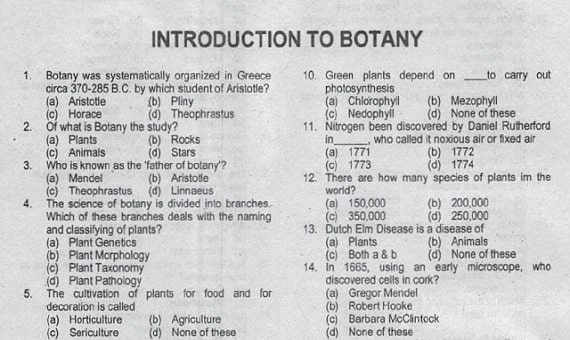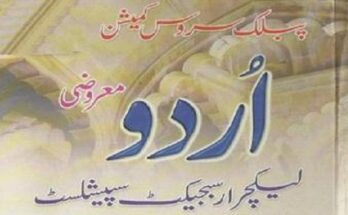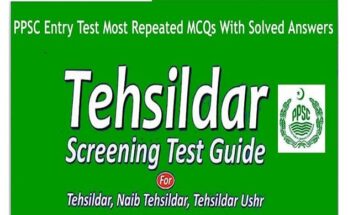Test PPSC 2019 Subject BOTANY With Full Book Download in PDF
INTRODUCTION TO BOTANY
1. Of what is Botany the study?
(a) Plants (b) Rocks
(c) Animals (d) Stars
2. X ray, is invented by: .
(A) Roentgen (B) Stephen Hawking
(C) Fleming (D) Pasture
3. The culbvation of plants for food and for decoration is called
(a) Horticulture (b) Agriculture
(c) Sericulture (d) None of these
4. The scientific study of plants Is called
(a) Botany (b) Zoology
(c) Eoology (d) None of these
5. Name the polson which Is present in the seeds of apple
(a) cyanogenic glycosldes
(b) Caladium
(c) Avocado
(d) Asparagus
6. Nitrogen been discovered by Daniel Rutherford In_,who called it noxious air or fixed air
(a) 1771 (b) 1772
(c) 1773 (d) 1774
7. There are how many species of plants im the wor1d?
(a) 150,000 (b) 200.000
(c) 350,000 (d) 250,000
8. In 1665, using an ear1y microscope, who drscovered cells in cork?
(a) Gregor Mendel
(b) Robert Hooke
(c) Barbara McClintock
(d) None of these
9. Who discovered ‘lumping genes’ by studying maize?
(a) Barbara McClintock
(b) Robert Hooke
(c) Gregor Mendel
(d) None of these
10. The Llnnaean syatem was Introduced by
(a) Barbara McClintock
(b) Robert Hooke
(c) Gregor Mendel
(d) Cart Unnaeus
11. How many Pakistanis are the member of British Paril ament?
(A) 10 Members (B) 12 Members
(C) 9 Members (D) 13 Members
12. Which Swedish scientist established binomial nomenclature?
(a) Carolus Unnaeus
(b) Barbara McClintock
(c) Robert Hooke
(d) Gregor Mendel
13. Angiosperms whose life cycles are more than two years are known as _
(a) Biennial (b) Perennial
(c) Annual (d) None of these
14. Which Swedish botanist invented binomial nomenclature?
(a) Lappan, Gjord
(b) LaSalle, Barbro
(c) Unnaeus, Carolus
(d) Leopold, Nathan
15. Range of Newly Tested Missile Ababeel IS ?
(A) 2100 kms (B) 2400 kms
(C) 2200 kms (D) 2400 kms
16. What is Celluloses?
(a) Fats (b) Carbohydrates
(c) Vitamins (d) Protein
17. The most important foods are derived from
(a) Leaves (b) Stem
(c) Fruits (d) Roots
18. Which of the following is found in plant cells, but not animal cells?
(a) Cell wall (b) vacuole
(c) Mitochondria (d) Reticulum
19. A large number of ldenUoal plants oan be obtained In a short span of Ume through –
(a) Tissue culture technique
(b) hydroponics method
(c) Stem cuttings
(d) Large number of seeds of a single plant
20. Which of the following fooctltemsls rich in Iron?
(a) Apple (b) Rice
(c) Orange (d) Pulses
21. How to open the file in Microsoft word?
(A) Ctrl+ 0 (B) Ctrl + D
(C) Ctrl + U (D) None of these
22. Essential constituent of plant cell is which type of carbohydrate?
(a) Sucrose (b) Starch
(c) Ugnin (d) Cellulose
23. Quinine Is a resource.
(a) Mineral (b) Agricultural
(c) Forest (d) None of these
24. Which one Is the rootless plant?
(a) Pistla (b) Monochoria
(c) Eichhomla (d) Ceratophyllum
25. Sandalwood tree Is considered a:
(a) Partial root parasite
(b) Stem parasite
(c) Total stem parasite
(d) Total root parasite
26. Development of fruit without fertilization is
(a) Parthenogenesis (b) Apomixes
(c) Parthenocarpy (d) Fertilization
27. In plants water is absorted by the root hairs by a process called.
(a) Respiration (b) Transpiration
(c) Osmosis (d) Perspiration
28. Cell wall of chloroplast Is removed, the remaining Iscalled
(a) Etloplast (b) Aleuroplast
(o) Amylopaat (d) Protoplat
29. Which tissue Is responsible for the passage of water In planta?
(a) Sclerenchyma (b) Xylem
(c) Phloem (d) None of these
30. Which of the following teeds can benefit a patient of diabetes mellitus by normalizing his
blood sugar level?
(a) Coriander seeds (b) Mustard seeds
(o) Fenugreek seed (d) Cumin seeds
31. SO. Potato is a modified form of
(a) Root (b) Stem
(c) Fruit (d) Leaf
32. Which of the following is a parasitic plant?
(a) Marcflantia (b) Kelp·
(c) Mushroom (d) Pteris
33. Which of the following is a carmvorous plant?
(a) Urn plant (b) Pitchet: plant
(c) Cacti (d) Ribbon plant
34. When we eat cauliflower we consume
(a) Leaf (b) Stem
(c) Flower (d) Inflorescence
35. When both sexes are absent from a ftower or are non-funcllonal ,the flower is said to
(a) Incomplete (b) lntecsexual
(c) Neuter (d) Unisexual
36. The smallest ftowering plant is
(a) Amarphophallus
(b) Azadaachtandica
(c) Ereclalndica
(d) WoltfaArrtliza
37. Plants that grow in saline water are called
(a) Halophytes (b) hydroohytes
(c) mesophytes (d) xerophytes
38. Plants synthesize protein from
(a) Starch (b) sugar
(c) Amino acids (d) fatty acids
39. Plants receive their nutrients mainly from
(a) chlorophyll (b) atmosphere
(c) light (d) soil
40. P1ants absorb most of the water needed by them through their
(a) Embryonic zone
(b) Grow1ng point
(c) Root hairs
(d) Zone of elongation
41. Our Skin becomes darl(, when exposed to excess sunlight. This Is because of our skin pigment cafted
(a) Ftavoxanthm (b) Melanin
(c) Carotene (d) Xanthopny II
42. The wot1d’s largest ftower (Approximately meter In diameter) belong to genus
(e) Nelumbo (b) Raffleala
(o) Mango (d) Anacardlum
43. Scarification of seeds Is done for removing
(a) Dormancy (b) Germination
(c) Growth (d) Embryo
44. Rubber Is obtained from
(a) lateK (b) cell sap
(c) Gun (d) rttin
45. Pulses are a good source of
(a) Carbohydrates (b) Fats
(c) Proteins (d) Vltamlna
46. Planta wilt due to excett of transpration
(a) Root (b) fruit
(c) Seed (d) stem
47. Banana fruit CiOiltalna mainly
(a) Glucose (b) atarch
(c) Fat (d) proteins
48. A plant eel is distinguished from an ooimal Q!ll by the presence of .
(a) Nucleus (b) Chloroplasts
(c) Cell membrane (d) Cell wall
49. Pollen grains in plants ae produced In
(a) Roots (b) Leaves
(c) Flower (d) Stem
50. Green piCilts manufacture food In the presence of
(a) Light (b) dailness
(c) Heat (d) mineral salts





